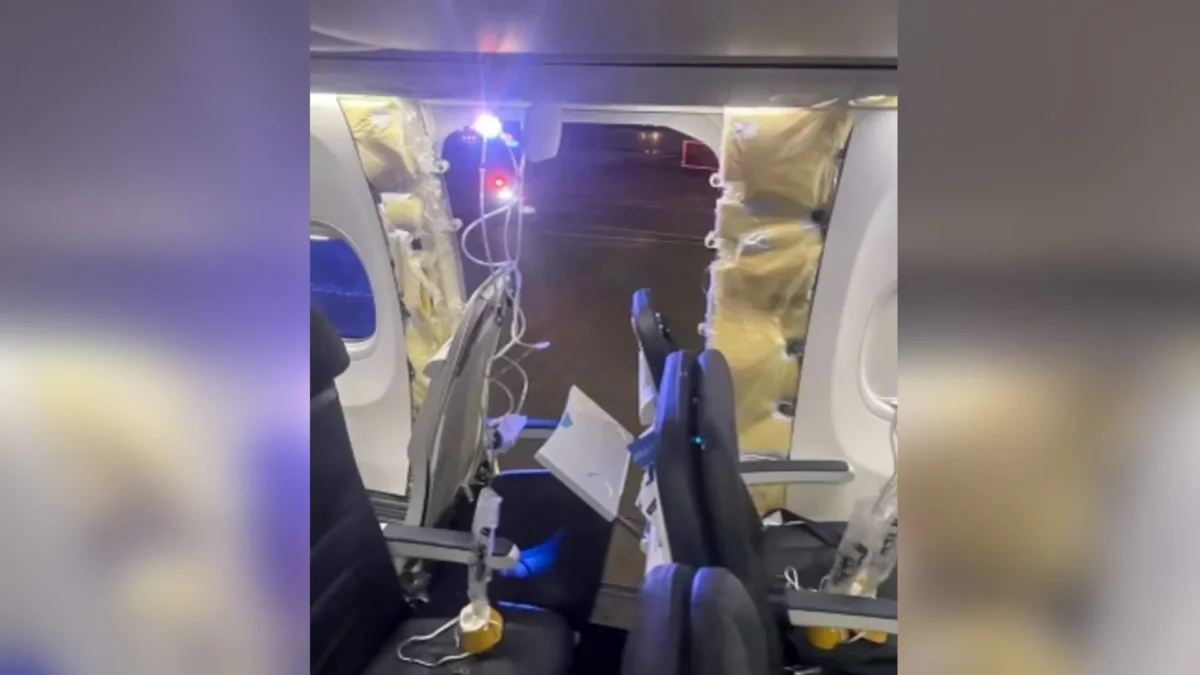United Airlines said Monday that it found issues related to the installation of door plugs—including loose bolts—while inspecting Boeing 737 Max 9 planes after a harrowing in-flight blowout of a door plug on this type of aircraft over the weekend led to a federal order to carry out enhanced inspections.
“Since we began preliminary inspections on Saturday, we have found instances that appear to relate to installation issues in the door plug—for example, bolts that needed additional tightening,” United said in a statement to The Epoch Times.
The carrier added that its technicians would remedy the problems and “safely return the aircraft to service,” adding that it’s still waiting for final approval from the Federal Aviation Administration (FAA) on the full inspection process.
It comes after an Alaska Airlines flight en route to California from Oregon made an emergency landing on Jan. 5 after the door plug—a panel covering an unused emergency door on the jetliner—blew out, leaving a gaping hole and leading to rapid cabin decompression.
None of the 171 passengers or six crew members were seriously injured. National Transportation Safety Board (NTSB) Chair Jennifer Homendy said the two seats next to the part that tore off were unoccupied

‘Enhanced Inspections’
The incident prompted the FAA to issue an emergency directive requiring immediate inspections of Boeing 737 Max 9 planes before they can be returned to service because the agency determined the unsafe condition “is likely to exist or develop in other products of the same type design.”
Alaska Airlines and United both grounded their Max 9 fleets and have been carrying out the newly mandated “enhanced inspections,” which include both left and right cabin door exit plugs, door parts, and fasteners such as bolts.
The FAA’s decision to ground the airplanes prompted hundreds of cancellations.
The NTSB said Monday it had found the dislodged door plug of the Alaska Airlines plane near Portland and will send it for lab analysis as part of its investigation.
Besides requiring the enhanced inspections of the Max 9 planes, the FAA also required carriers to fix any issues they discover before the aircraft can be returned to service.
Hundreds of Cancellations
Alaska Airlines and United Airlines, which are the only two U.S. carriers to use the Max 9 aircraft, canceled a total of 387 flights as of the afternoon of Jan. 8, according to tracking site FlightAware.
Alaska Airlines, which operates 65 of the Max 9 planes, canceled 154 flights.
The carrier said in a statement on Jan. 8 that it was still waiting for further clarification from the FAA before it could begin the inspections as the agency must first approve the enhanced inspection processes for which the carrier must develop detailed instructions for its technicians to follow.
“As we await further information from the FAA and work through these important steps, our technicians have prepared each aircraft to be immediately ready for the required inspection when instructions are finalized,” Alaska Airlines said in the statement.
The company added that some questions would remain unanswered about the incident on the Alaska Airlines flight while the investigation remains pending.
“We recognize that additional questions remain about the details surrounding Flight 1282 that we are unable to address at this time,” the company said. “Because this is an active investigation, we must receive permission from the NTSB to provide information about the aircraft and its prior maintenance. We will provide information as soon as the NTSB permits us to do so.”
United, which canceled 233 flights and has 79 of the affected aircraft in its fleet, told The Epoch Times in an emailed statement that it’s working with the FAA to “clarify the inspection process and requirements for returning the Max 9 aircraft to service.
“We are working with customers to reaccommodate them on other flights and in some cases have been able to avoid cancellations by switching to other aircraft types,” United said.
The FAA estimated that roughly 171 airplanes worldwide would be affected by its enhanced inspection order.
The Incident
Alaska Airlines Flight 1282 was en route to Ontario, California, from Portland, Oregon, when the incident occurred, forcing an emergency landing.
The door plug blowout took place about six minutes into the flight when the aircraft reached an altitude of about 16,000 feet.
The pilot declared an emergency, notifying air traffic control of a depressurization issue.
Social media footage showed a window and a portion of a side wall panel missing on the airplane and oxygen masks deployed.
Images of the aircraft shared by passengers onboard seem to indicate that, during the flight, the rear mid-cabin exit door became detached from the aircraft, Flightradar24 reported on its website.
The new Boeing 737 MAX 9 was delivered in late October to Alaska Airlines and certified in early November, according to FAA data.
Boeing said in a statement that it is looking into the incident.
Boeing has faced previous issues with its 737 Max 8 model, leading to its grounding worldwide between March 2019 and December 2020.
The groundings followed two fatal crashes involving the model: Lion Air Flight 610 on Oct. 29, 2018, and Ethiopian Airlines Flight 302 on March 10, 2019, resulting in a combined total of 346 fatalities.
In April, a manufacturing issue was discovered in the 737 Max 8 model related to the installation of fittings in the rear fuselage. Boeing insisted it was not an immediate safety concern, and the FAA validated that conclusion, allowing affected planes to continue flying while inspections were conducted.
At the end of December, Boeing urged airlines to inspect newer 737 Max models for a possible loose bolt in a key flight control system after an international operator found a bolt with a missing nut in the rudder and Boeing found a similar issue on an undelivered plane.
Caden Pearson contributed to this report
From The Epoch Times

